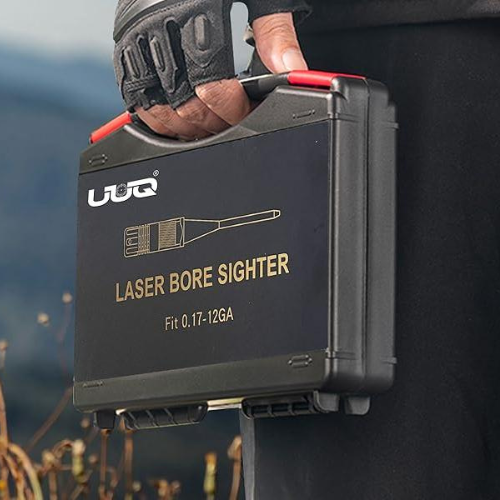
Ever wondered how to improve your shooting accuracy without wasting ammunition?
Using a laser bore sight to align your rifle scope offers precision and efficiency in sighting your target. This method provides a straightforward way to adjust your scope, minimizing trial and error.
Ready to transform your shooting experience with this comprehensive guide?
The Basics of Bore Sighting
Bore sighting helps align your rifle scope with the bore of your rifle, ensuring greater accuracy when shooting.
Different types of bore sights, including laser bore sights, are used for precision and efficiency.
The initial bore sighting process establishes a baseline for further refinements.
Bore Sighting and Its Purposes
Bore sighting is the process of adjusting your rifle's scope to align with the rifle's bore. This is critical for achieving accuracy.
Before you hit the shooting range, bore sighting provides a dependable starting point, aligning your scope reticle with the target.
Distinct Types of Bore Sights
There are several types of bore sights, each offering different methods of achieving alignment.
Laser bore sights are popular due to their precision and ease of use. These devices project a laser beam through the bore, aligning it with your scope reticle without needing live ammunition.
Optical collimators use a grid or optical pattern viewed through the scope. These are more traditional and require a bit more skill to use effectively.
Magnetic bore sights attach to the barrel and rely on magnetism to assist in alignment.
Each type has unique benefits, so consider your needs and preferences when selecting the right bore sight for your setup.
A properly aligned scope minimizes the need for drastic adjustments during actual shooting. This adjustment process uses both mechanical and optical alignment.
By having your rifle's scope in sync with the bore, you enhance shooting precision and reduce ammunition waste.
The Importance of Initial Bore Sighting
Initial bore sighting is your foundational step to achieving a well-zeroed rifle scope.
Before making fine-tuning adjustments on the range, this process sets up your scope to align closely with the bore, getting you closer to the target.
You don't want to waste time or ammunition by skipping this step.
This process sets the groundwork for achieving accuracy on the field. Correcting the major misalignments here makes a big difference when you start live firing.
Resolving large discrepancies early ensures you only need minor tweaks during zeroing. Thus, starting with initial bore sighting can save wear and tear on both your patience and wallet.
Preparation for Bore Sighting

Before you start bore sighting a rifle with a laser, preparation is key. The right setup, equipment choice, and attention to safety will set you up for success and accuracy.
Safety Measures and Preliminary Checks
Safety is non-negotiable when dealing with firearms.
Remove the bolt from the rifle. This is crucial in ensuring there is no ammo in the chamber.
Double-check to verify the firearm is unloaded. Treat the rifle with respect, just like a school teacher shown the proper etiquette.
While working with firearms, use protective eyewear. This helps prevent any accidental injuries.
Having all your equipment within reach reduces unnecessary movements.
Verify that the laser bore sighter is in working condition by testing its alignment on a non-reflective surface.
How To Select the Proper Laser Bore Sighter
Choosing the right laser bore sighter influences the accuracy of your setup.
Consider the caliber of your firearm and find a bore sighter accordingly. Ensure compatibility to avoid unnecessary adjustments later on.
Options range from universal kits to caliber-specific models. Each has its pros and cons.
Universal kits are versatile across multiple firearms, while specific models cater to one bore size.
Investigate different brands for reliability.
Check reviews for user experiences similar to others on Yelp.
How To Position the Rifle with Support
Proper positioning is a pillar of accuracy.
You should use a stable surface like a gun vise or sandbags to minimize movement. This keeps the rifle steady and aligned with your target.
Adjust your equipment for eye level alignment.
The laser bore sighter should align well with the rifle’s bore and your line of sight.
Positioning isn't just a quick step, but one that affects precision.
Level the rifle horizontally. Tools like a bubble level can assist here.
Proper support reduces the chance of error when you finally head to the range.
Step-by-Step Laser Bore Sighting Process
Laser bore sighting is an essential task to align your rifle scope to the rifle's barrel for accurate shooting.
This process involves a series of straightforward steps to achieve precise alignment between the reticle and the bore's center, ensuring the laser dot stays centered.
Align the Laser with the Rifle's Barrel
First, get your bore sighter ready. Insert the laser bore sight into the end of the barrel. Depending on its type, it may go into the muzzle or be placed in the chamber.
Ensure the laser is centered by adjusting it until the dot shines steadily on a distant surface.
Use a target placed around 100 yards away for precise alignment. Proper alignment minimizes guesswork and gets you closer to hitting the bullseye on your first shot.
Adjust the Rifle Scope's Reticle to Match the Laser Dot
Next, set up your rifle on a stable platform. Look down the scope to view the target. You’ll notice the reticle might not match the laser dot.
Use the scope's windage and elevation dials to adjust the reticle until it aligns with the laser dot on the target.
Move the windage dial for left and right adjustment and the elevation dial for up and down.
Don’t rush this step. Aligning the reticle with the laser dot ensures that your shots will be on target when you’re zeroing the rifle.
Verify and Tweaking the Point of Impact
Finally, it's time for verification. Your reticle should align closely with the bore's laser.
Take a few test shots from a secure position to check if the point of impact (POI) matches where you aimed with the laser and scope.
Consider external factors like wind and bullet drop.
If the POI doesn’t hit where expected, slight tweaks to the windage or elevation may be necessary.
Remember, even minor adjustments can significantly enhance accuracy.
Final Adjustments and Post-Bore Sighting Checks
After bore sighting your rifle, it's important to perform final adjustments and checks to confirm accuracy and reliability.
You'll want to fine-tune for precision, verify the rifle scope's accuracy, and take care of your bore sighting equipment.
This approach helps maintain the best shooting performance and extends the lifespan of your equipment.
Fine-Tune for Precision
Once the laser bore sighting is complete, you should fine-tune your rifle scope by adjusting it on a 25 to 100-yard range.
Start with closer targets, like 25 yards, to make more precise adjustments before extending to longer distances. This approach helps "get you on paper" and provides a baseline for further correction.
At each distance, ensure your shots are properly aligned with the target center.
Make slight adjustments using the windage and elevation turrets to align the shot group with the bullseye.
Consider the caliber-specific ballistics of your ammunition, which may impact trajectory and precision.
Firing a group of 3 shots helps confirm your adjustments.
If the group is not aligned with your aim, re-evaluate your settings until you achieve precision.
Test and Confirm Rifle Scope Accuracy
Once you're dialed in, test the accuracy and consistency at different distances, such as 50 yards or more.
Use three-shot groups to evaluate how well the scope holds zero at each range. The target should indicate whether further fine-tuning is needed.
Testing under different conditions, like varying light and wind, provides insights into your setup's reliability.
Double-check the scope's mounting to ensure it is still secure, as any movement can affect accuracy.
This testing verifies that your setup is ready for real-world use, building confidence in hunting or shooting scenarios.
Maintenance and Storage of Bore Sighting Equipment
Maintain your bore sighting equipment by cleaning and storing it properly.
Dirt and debris can affect its function and accuracy.
Use a soft cloth to wipe down the bore sighter and other components after use.
Store your equipment in a dry, secure location to prevent damage from moisture or impact.
A dedicated case or compartment helps organize your gear.
This ensures that everything is ready for your next shooting session.
Regular maintenance keeps your equipment in peak condition, providing reliable performance every time.

